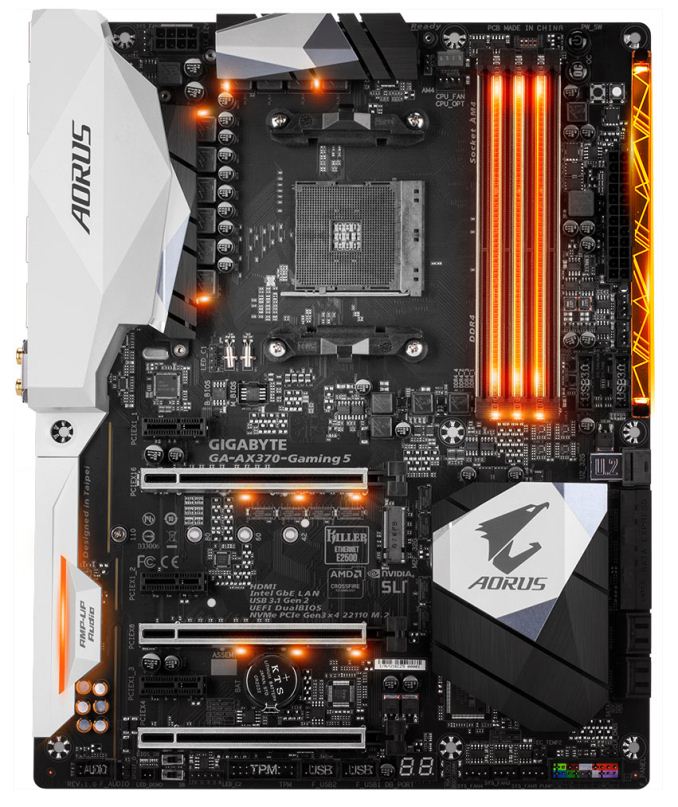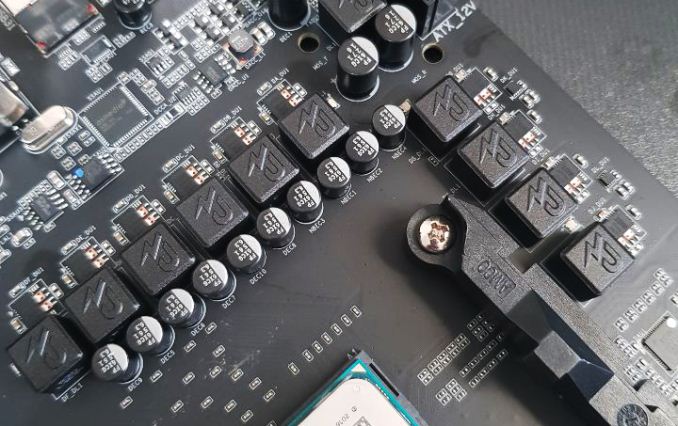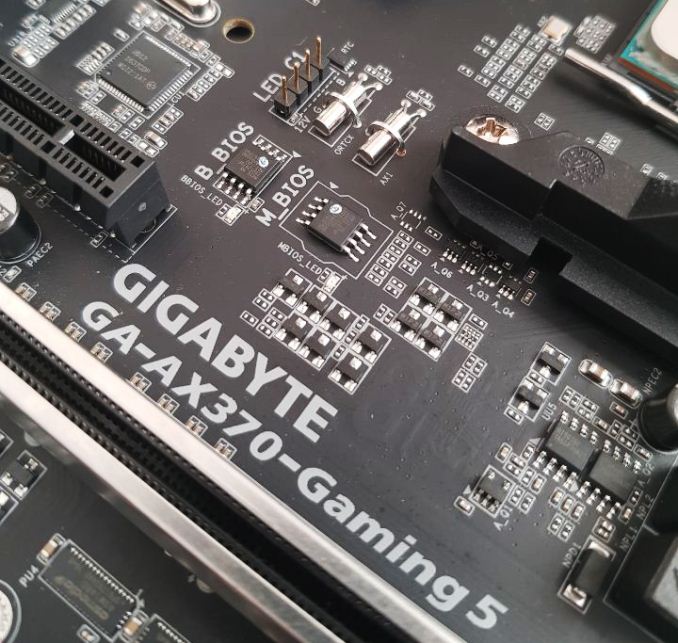The GIGABYTE Aorus AX370-Gaming 5 Review: Dual Audio Codecs
by Gavin Bonshor on November 14, 2017 12:30 PM ESTGIGABYTE Aorus AX370-Gaming 5 Board Features
The Gaming 5 has a lot about it if we factor in the high volume of connections and inputs on a sub $200 offering. Physically Gaming 5 has support for both 2-way SLI and 3-way CrossFire multi-graphics configurations, although theoretically there is support for up to 4-way SLI and 4-way CrossFire with GPUs featuring two GPU cores on a single PCB. GIGABYTE is known for emphasizing its onboard audio solutions on their range of upper-end boards, but the AX370-Gaming 5 features dual Realtek ALC1220 codecs with the second designed specifically for the front panel audio.
| GIGABYTE Aorus AX370-Gaming 5 ATX Motherboard | |
| Warranty Period | 3 Years |
| Product Page | Link |
| Price | $174 |
| Size | ATX |
| CPU Interface | AM4 |
| Chipset | AMD X370 |
| Memory Slots (DDR4) | Four DDR4 Supporting 64GB Dual Channel Up to 3200 MHz |
| Video Outputs | HDMI 1.4 |
| Network Connectivity | Killer E2500 & Intel I211-AT |
| Onboard Audio | Realtek ALC1220 |
| PCIe Slots for Graphics (from CPU) | 2 x PCIe 3.0 (x16, x8/x8) |
| PCIe Slots for Other (from PCH) | 1 x PCIe 2.0 (x4) 3 x PCIe (x1) |
| Onboard SATA | Eight, RAID 0/1/10 |
| Onboard M.2 | 1 x PCIe 3.0 x4, on Front |
| USB 3.1 (10 Gbps) | 1 x Type-C 3 x Type-A |
| USB 3.0 (5 Gbps) | 2 x Rear Panel 4 x Header |
| USB 2.0 | 4 × Header |
| Power Connectors | 1 x 24-pin ATX 1 x 8-pin CPU |
| Fan Headers | 1 x CPU (4-pin) 4 x System (4-pin) 2 x System/Pump (4-pin) |
| IO Panel | 6 x USB 3.1 (USB 3.1 Gen 1) 3 x USB 3.1 (USB 3.1 Gen 2) 1 x USB 3.1 Type-C 2 x Network RJ-45 1 x HDMI 1.4 1 x Combo PS/2 5 x 3.5 mm Audio Jacks 1 x Optical SPDIF Out Port |
Visual Inspection
The Gaming 5 has a wave of customisable RGB LED zones across multiple areas. Going from left to right, there is are subtly placed LEDs in the plastic audio component cover, and next to this are a couple of single LEDs placed at either side of the chokes in the VRM area. In the center, and under each of the two PCIe x16 3.0 slots, we get three LEDs forming a strip directly under the slots. On the right-hand side, there is an array of lighting in between the memory slots, and an LED bar on the right using a plastic pattern that can be replaced.
The top right-hand corner of the board features (what I like to call) 'a basic overclockers toolkit', and consists of a power button, a one-click OC button and small reset CMOS and system reset buttons. There also are five 4-pin PWM headers (including CPU) on the board, with two high-powered fan headers for users with water cooling pumps. The audio area has the pair of Realtek ALC1220 codecs, for both rear and front panel audio, which uses gold Japanese Nichon audio capacitors. Nippon Chemi-Con 10k solid capacitors are used elsewhere on the board and are black in colour.
Aside from the single and centrally located PCIe x4 NVMe M.2 storage slot, the rest of the storage options can be found on the lower right-hand side of the board. There are eight SATA 6Gb/s ports as well as two SATA Express ports. To the right is a single U.2 port as well.
With the power delivery, GIGABYTE is using a 10-phase digital power design. The VRM is controlled by am International Rectifier IR35201 digital PWM controller, running in 4+2 mode, with an IR3599 doubler bringing the count to 8+2. Supplementing the VRM controller, the board utilizes the International Rectifier IR3553M 40A MOSFETs and GIGABYTE's own designed ferrite core chokes.
One of the more premium features on the Gaming 5 is having a dual BIOS system. The BIOS in use can be selected via a switch on the board. At the bottom of the board just located below the bottom PCIe x16 slot are two switches which allow the user to change the configuration of the BIOS implementation: when switched into single mode, each of the two BIOS chips can run different BIOS versions (which is handy for overclockers who use different BIOS versions depending on the CPU model). When selecting the dual BIOS mode, they run in a mirror configuration; it reflects the image across both of the BIOS chips for redundancy purposes.
On the rear panel, there is single USB 3.1 Gen 2 Type-C port and single USB 3.1 Gen 2 Type-A port which are supported via the ASMedia ASM1143 USB controller. Also present is an additional two USB 3.1 Gen 2 type-A ports as well as six USB 3.0 ports and 3.5mm audio jacks for the onboard audio with S/PDIF output. A lot less emphasis has been placed on the onboard graphics as a there is only a single HDMI 1.4 output, with GIGABYTE showing its intent to market this board primarily to those planning on to use discrete graphics. There are two physical network ports, using the Rivet Networks Killer E2500 chip and the Intel I211-AT controller. Also present is a combination PS/2 port.














34 Comments
View All Comments
The_Assimilator - Tuesday, November 14, 2017 - link
Seems like Gigabyte have run out of ideas to differentiate their boards from competitors, so now they're just slapping random junk on. "Oooh I know a second audio codec!"Why are there so few boards that don't waste money on "premium" audio? As someone who uses a USB headset, this has no value for me. Plus if I actually wanted actual premium audio, I'd pick up a discrete audio card anyway.
It really disappoints me that the motherboard industry has degenerated to the point of "great features/connectivity, great overclocking, no useless addons like LEDs: pick one".
Reginald Peebottom - Tuesday, November 14, 2017 - link
I agree the dual audio seems to be a pretty useless feature for the vast majority of users along with the killer NIC - I’d rather an Intel nic or even a Realtek and save the money.There’s a lot of motherboards that don’t use premium audio or NICs, if that’s what you want, but stand alone audio cards are much more of a rarity now along with stand alone NICs for home use.
Just get the B series chipsets.
The_Assimilator - Wednesday, November 15, 2017 - link
B350 has 4 fewer USB 3.0 (3.1 Gen1) ports, 2 fewer SATA ports, and 2 fewer PCIe 2.0 general-purpose lanes. It also misses out on SLI support and PCIe bifurcation. So not really an option.Seems like to get something decent I have to look at the HEDT market or "workstation" class boards, both of which carry a price premium for removing useless gimmicky crap that nobody wants or needs.
khanov - Tuesday, November 14, 2017 - link
It should be mentioned that this board has major incompatibility issues with a variety of expansion cards. Most SATA/SAS cards do not work, whether in IT or RAID mode, doesn't matter. Other common cards that don't work are some USB3.0 and 3.1 cards and some NICs. Pretty much anything with an option rom is unlikely to work in this motherboard and so far Gigabyte have been unwilling to address the issue.SRB181 - Tuesday, November 14, 2017 - link
Actually, it's worked with every Host bus adapter I've thrown at it. From scsi to fibre channel.If it's UEFI compatible, just let it boot. It takes the same time to initialize as if it loaded bios.
To use legacy cards, set the storage boot option control, or, other pci boot device option
to "legacy only" and they will load the card bios
JTDC - Tuesday, November 14, 2017 - link
Sorry to ask such an elementary question but can one of the two slots designated as being for graphics be used for other devices? Thanks.khanov - Tuesday, November 14, 2017 - link
Yes, you can use one slot for graphics with 8x lanes and the other for something else with up to 8x lanes. I just tested this with an intel NIC in the 2nd slot and it works. But you need to read my comment above. This board has compatibility issues with a lot of expansion cards, so depending on what you want to plug in, it might not work in any slot on this motherboard.I've confirmed that these cards DON'T work in this motherboard:
LSI 8888ELP SATA/SAS RAID card
3Ware 9650SE SATA RAID card
ASMedia 1061 2x SATA 3 card
Generic USB 3.0 2-port card
I'm willing to be a lot of other SATA/SAS card don't work either, but I don't have any more to test with.
SRB181 - Tuesday, November 14, 2017 - link
I don't think you have the bios set right. Have tested it with Adaptec ASR-5405z, ASR-6805t(both legacy and UEFI), both sas, IBM LPE 12002 Emulex Fiber channel and HP LPE 11002
cards (First UEFI, second legacy), and Adaptec 29329 LPE scsi card (legacy).
I ran a lot of these cards in the 1x slots with cable adapters to 16x and they worked fine
(just slower). About this time, I realized I could use more PCI-e lanes. Bought a Gigabyte x399
gaming 7 to use them with. Good luck
khanov - Wednesday, November 15, 2017 - link
I'm glad to hear that at least some storage adapters work with this board. I can confirm that the ones I listed do not work. I did of course have the two PCI device options (storage and other) on Legacy Only, and I've tried every other combo as well. The option roms of those cards I listed don't load in this board.I have been in contact with Gigabyte over this issue for more than a month, but they are unable (unwilling?) to fix it. I even offered to send them a spare 3Ware 9650SE but they were not interested.
They did confirm the issue with the ASMedia 1061 card and offered a partial fix that only works with motherboard SATA ports set to AHCI. I would say to anyone thinking of buying this board: Check with Gigabyte that your expansion cards will work first.
rsandru - Wednesday, November 15, 2017 - link
I own this board too and while I like it a lot, I can confirm Gigabyte support is complete garbage. I've been trying to have them resolve an SLI related problem since May, and gave up after several useless ticket exchanges with their support team. Next board will most certainly not be a Gigabyte...